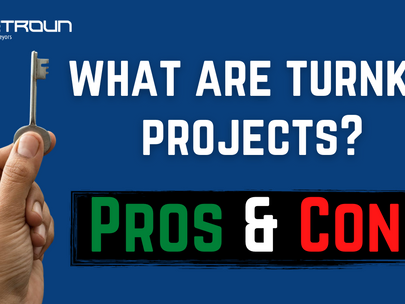A Turnkey project is the name given to a delivery method where a single contractor works with the client under a sole contract. This contractor becomes responsible for all stages of a project from detailed design and engineering, through construction and project management to project completion. Meaning, all the client has to do is simply pick up the keys from the contractor, pop the keys into the lock of their shiny new building and turn to enjoy all it has to offer.
This can be extremely attractive to clients as the method consolidates project design, financing, subcontracts, procurement and construction delivery all into one place with a single point of accountability. Additionally, the turnkey delivery method can be used for a vast range of different and complex projects in all sorts of industries such as: Logistics, Energy, Pharmaceuticals, you name it!
Of course, there are advantages and disadvantages to all delivery methods and the Turnkey solution is no exception. So lets take a look at the pros and cons..
Advantages
Price Certainty – In contrast to the traditional Design, Bid, Build approach, turnkey methods can help to reduce financial unknowns and provide clients the ability to more accurately calculate return on investment. Additionally, with traditional methods, the construction cost can often be unclear until it has a final design and tenders from the bidding contractors returned. If a separate company lacking strong construction experience was hired to design and engineer the project, they may not be able to achieve the desired outcomes within the given budget.
Reduced Change Management Challenges – When using the Design, bid, build method, there is generally no or little connection between the company that engineers and designs the project and the company that physically builds it. This dynamic can result in inconsistencies with the engineering design and the clients’ actual needs. It is therefore possible for this to lead to numerous variations that can continue to cause price increases throughout the project. Errors and omissions can also be charged as a variation, leading to increased cost and delays. With turnkey approaches, this challenge is greatly reduced, as everything in the “Issued for Design” package is included within the price.
Shortened Project Timelines – Due to the nature of a turnkey project, many stages of the construction process may overlap by having a single design and construction contractor. For example, procurement of materials and subcontractors can occur as designs are being finalised. This overlapping of activities can all help to reduce the timeline and eliminate potential delays throughout the process.
Collaborative Approach – The turnkey method is a model based on collaboration —the engineers / designers and builder work as a team, with aligned interests. This helps to eliminate the adversarial nature that can sometimes cause issues on a project that employs the in the Design, Bid, Build model. The turnkey approach reduces the amount of blaming and finger-pointing that may otherwise be involved in more traditional methods.
Risk Transference – On a turnkey project, much of the project risk and responsibilities that traditionally would sit with the client is transferred to the contractor. This is due to the fact that they are the ones in control of, and is held accountable for the programme, cost, and overall performance of the project.
Disadvantages
For a client to engage on a turnkey project it requires a very strong scope definition: by this, we mean that the scope and desired outcomes of the project must be fully clear before entering the engineering and design phase of a turnkey project. Making changes and adding or removing components to the project after this phase can waste previous time and cost spent on activities that have already commenced and need to be amended or removed altogether.
The success of a turnkey project can often come down to trust: To have good collaboration between parties, you need trust and so naturally this approach depends heavily on the clients trust in the contractor and visa versa. Finding the right contractor that understands the client’s vision, budget, and construction needs is pivotal but of course, this can be difficult to find if the client doesn’t already have a relationship or previous experience with a competent contractor.
Cost: The project budget is generally calculated and shared before the design is fully complete and finalised. It is therefore important to try and account for unpredictable changes such as inflation (depending on the length of a project), material and labour price rises for example, which is not an easy thing to do and get accurate. And these changes can significantly affect the clients’ original budgets.






